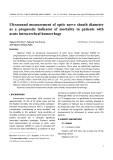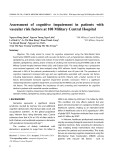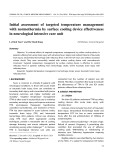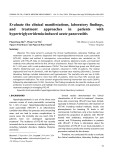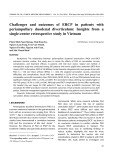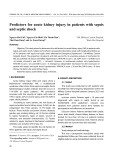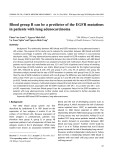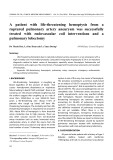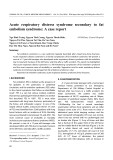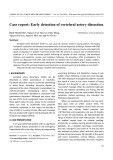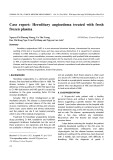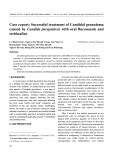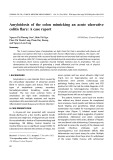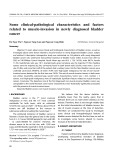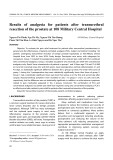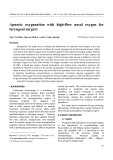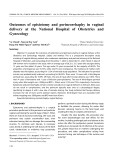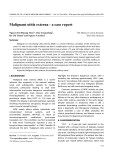
HUE JOURNAL OF MEDICINE AND PHARMACY ISSN 3030-4318; eISSN: 3030-4326HUE JOURNAL OF MEDICINE AND PHARMACY ISSN 3030-4318; eISSN: 3030-4326
180 181
Hue Journal of Medicine and Pharmacy, Volume 15, No.2/2025 Hue Journal of Medicine and Pharmacy, Volume 15, No.2/2025
Development of an in situ gel containing tinidazole-loaded polymeric
nanoparticles for oral cavity administration
Ho Hoang Nhan* , Phan Thi Thao Ngoc
University of Medicine and Pharmacy, Hue University
Abstract
Background: Tinidazole (TNZ) demonstrates greater efficacy against anaerobic bacteria, particularly
Gram-negative strains, compared to metronidazole. Nanosizing TNZ and incorporating it into in situ gel
formulations for topical periodontitis treatment offers several advantages. Objectives: This study aimed to
formulate an in situ gel containing preformed Eudragit RSPO-based nanoparticles (NPs) of TNZ and to evaluate
its physicochemical properties. Materials and methods: Poloxamer 407 was used as a thermosensitive
gelling agent, either alone or in combination with other gelling agents. The in situ gels containing TNZ NPs
were prepared and evaluated for physicochemical properties. Results: The in situ gel containing TNZ NPs,
formulated with Poloxamer 407 and sodium alginate, exhibited a smooth texture, a gelation temperature
of 31.33 ± 0.24 °C, a gelation time of less than one minute, a pH of 6.72 ± 0.03, and a stable gel state over
an extended period. Compared to the in situ gel with TNZ material, the TNZ NP-loaded gel prolonged drug
release. The drug release mechanism was best described by the Higuchi model (with F0). Conclusion: This
TNZ NP-loaded in situ gel formulation shows promise for further research in periodontitis treatment.
Keywords: tinidazole, in situ gel, nanoparticle, poloxamer 407.
*Corresponding author: Ho Hoang Nhan. Email: hhnhan@hueuni.edu.vn
Received: 19/12/2024; Accepted: 15/4/2025; Published: 28/4/2025
DOI: 10.34071/jmp.2025.2.25
1. INTRODUCTION
Periodontitis is a chronic inflammation of the
soft tissues that support teeth, causing damage to
periodontal structures, alveolar bone loss and even
tooth loss [1]. The principal agent primarily involved
in the formation and progression of periodontitis
is Porphyromonas gingivalis (P. gingivalis), a
gram-negative anaerobic bacterium. Therefore,
eradication of P. gingivalis is essential in the
treatment of periodontitis [2].
Topical antibiotics are the preferred choice in the
treatment of periodontitis because they are a simple
method and limit unwanted side effects commonly
encountered when using systemic antibiotics.
However, their effectiveness is limited because most
clinically used antibiotics can only remain effective
for a short period of time. At the same time, drugs in
periodontal pockets are easily washed away by saliva
in the gingival pocket, making it difficult to maintain
therapeutic concentrations at the site of impact [3].
Besides, resistance can easily occur when using
antibiotics continuously because bacteria have the
ability to produce biofilm around them to protect
them from the host’s defense mechanism. These
biofilms also act as a biological barrier to prevent the
penetration of antibiotics, protecting bacteria from
being destroyed by the treatment process, thereby
reducing the effectiveness of the drug and leading
to drug resistance [2]. Therefore, developing a drug
that can penetrate the biofilm and provide long-lasting
local effects is a big challenge.
With the development of nanotechnology in
medicine and pharmacy, nanomaterials have been
developed with many advantages such as small size,
increased ability to penetrate cells, reduced toxicity,
and biocompatibility,… [2].
Tinidazole (TNZ) exhibits higher susceptibility
to anaerobic bacteria, especially Gram-negative
bacteria. Moreover, systemic TNZ offers several
advantages compared to metronidazole for the
oral treatment of periodontitis [4]. Quantum dots
containing nanoscale TNZ have been reported
to effectively penetrate biofilm layers, thereby
inhibiting the growth of P. gingivalis [2]. In vitro
studies have demonstrated sustained drug release
for up to 20 days, along with significant antibacterial
activity achieved through TNZ-loaded nanofibers [5].
In situ gels are liquid preparations that can
be easily injected into periodontal pockets and
then form a gel with a specific shape, capable of
releasing drug at a controlled rate, maintaining drug
concentration in the gingival crevicular fluid for a
long time to achieve the desired clinical benefit [6].
Poloxamer 407 (PLX407) was widely used to form
in situ gels or in combination with other gelling
agents [7]. Carbopol 934P (CBP934), when dispersed
in water, forms a colloidal dispersion with acidic
properties. Upon neutralization, it transforms into a





